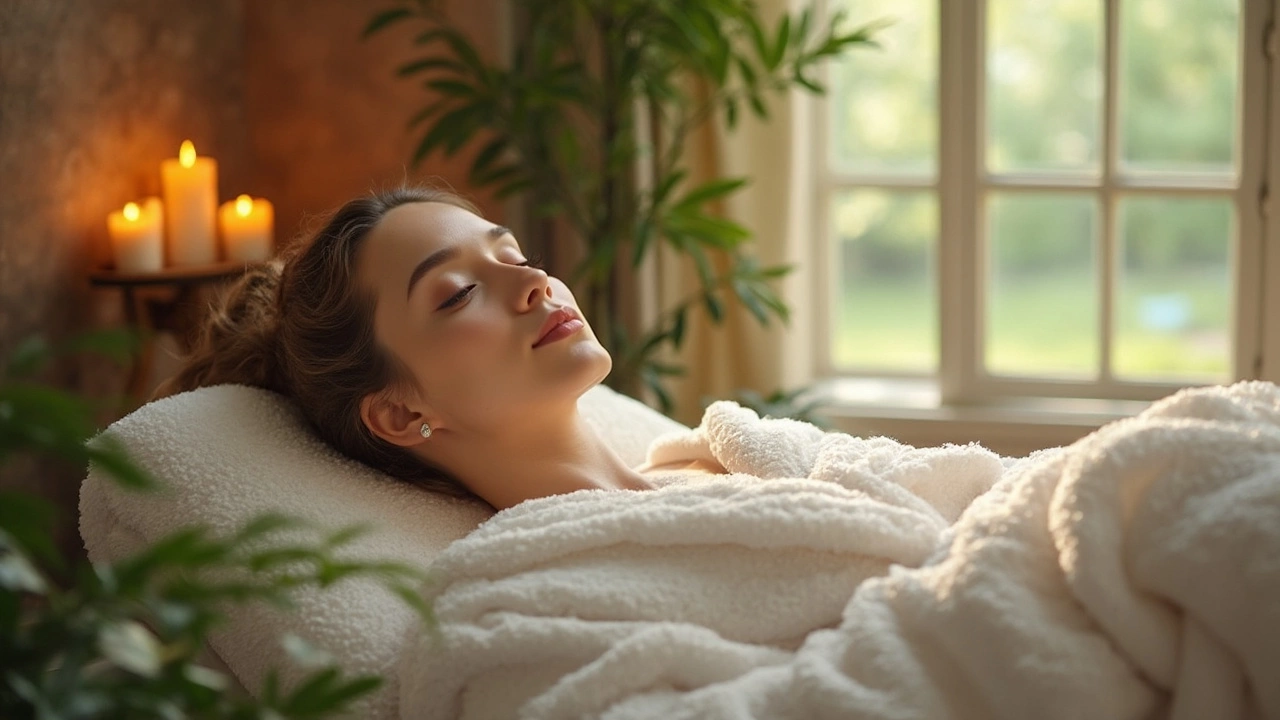Ever looked in the mirror and wondered why your skin isn't as radiant as you wish? Maybe you're just not giving it the right kind of love. Picking the perfect facial is pretty much like finding the right pair of jeans—it has to fit just right for the magic to happen.
First things first: knowing your skin type is key. Whether you're working with dry, oily, combination, or sensitive skin, each type has its demands. Understanding what camp you belong to can guide you to the facials that will have your skin gleaming.
It's easy to get lost among all those fancy facial names—Glow Getter, Deep Cleanse, Lift and Tone—what do they even mean? These names often hint at specific benefits like hydration, detoxifying, or anti-aging. Align these with what your skin truly needs, and you'll be on the right track.
- Understanding Your Skin Type
- Common Facial Types and Their Benefits
- How to Determine What Your Skin Needs
- Questions to Ask at the Spa
- Debunking Facial Myths
- Maximizing the Benefits Post-Facial
Understanding Your Skin Type
Figuring out your skin type is like getting a map to your face’s needs. Whether it’s oilier during summer or flaky across the bridge of your nose, these quirks help decide which facial treatments will work wonders for you.
Typically, skin types fall into a few categories:
- Dry Skin: Feels tight, especially after washing. It might look flaky or have red patches. What it needs? Moisture, moisture, and more moisture!
- Oily Skin: You're battling shine often. Large, visible pores and a tendency to break out are common. You’ll want facials that help with deep cleaning and balancing oil.
- Combination Skin: The best of both worlds... or sometimes the worst. Usually, a shiny T-zone with dry areas on the cheeks. Facials that can tackle both issues are your go-to.
- Sensitive Skin: Redness, itching, and burning mean skin that reacts easily. You’ll want gentle facials that soothe and calm.
Wondering how to pin down exactly what type you have? Here’s a quick test:
- Wash your face with a gentle cleanser and pat dry.
- Skip any products and wait about an hour.
- Look in the mirror and see what’s happening.
- If your skin feels parched, you’re likely in the dry category. If it’s shining like a disco ball, it’s leaning oily.
- If some parts are oily and others dry, hello combo skin! And if you notice redness or irritation, it’s likely sensitive.
Knowing your skin type helps in deciding between the array of facials - like selecting the right treatment for hydrating dry skin or calming a sensitive face. This simple understanding can really make each visit to the spa much more effective, ensuring your skin gets exactly what it needs.
Common Facial Types and Their Benefits
Walking into a spa and seeing a menu full of facial options can be a bit overwhelming, right? Let's break down some of the most popular facial treatments out there and what they can do for you.
Deep Cleansing Facial: This one's a classic and a favorite for those battling acne. It typically involves a mix of steam, exfoliation, and extractions to rid your skin of pesky blackheads and impurities. If your skin's feeling congested, this could be your go-to.
Hydrating Facial: Perfect for dry skin, this facial drenches your skin with moisture. Products rich in hyaluronic acid and vitamin E are used to plump and hydrate your skin, leaving it looking fresh and dewy.
Anti-Aging Facial: Want to tackle those fine lines and wrinkles? An anti-aging facial usually combines antioxidants, peptides, and sometimes even collagen masks to tighten your skin and boost elasticity.
Brightening Facial: If your skin's feeling a bit dull or you've got some uneven tones, a brightening facial might be the ticket. Ingredients like vitamin C and enzymes aim to reduce pigmentation and give your skin a healthy glow.
Calming Facial: Got sensitive skin that's prone to redness? Calming facials use soothing products with ingredients like chamomile and aloe vera to gently reduce inflammation and leave your skin feeling cool and less irritated.
- Oily Skin: Opt for facials that emphasize purification and oil control.
- Dry Skin: Look for facials that are heavy on hydration and nourishment.
- Combination Skin: You might benefit from facials that balance hydration across different areas.
Each facial type has its perks, and picking the right one depends on your skin's unique needs. Before booking, have a chat with your esthetician—they can help match you with the ideal treatment to make your skin happy.
How to Determine What Your Skin Needs
Figuring out what your skin actually needs can be confusing with all the options out there. But it’s important because choosing the right facial treatments helps get the glow you dream of. Start by taking a good look at your skin condition and noting any issues you're facing, like dryness, oiliness, uneven texture, or acne.
The simplest way to understand your skin type is the blotting sheet test. After washing your face and waiting an hour, press a sheet against various parts of your face. Oily skin will leave oily marks; dry skin, not so much. Combination skin usually has oil in the T-zone (forehead, nose, chin) but drier cheeks.
- Oily skin: Opt for facials that include clay masks or salicylic acid to absorb excess oils and unclog pores.
- Dry skin: Go for hydrating facials that incorporate hyaluronic acid or glycerin to lock in moisture.
- Sensitive skin: Choose gentle facials with calming ingredients like aloe vera or chamomile to soothe irritation.
- Combination skin: Balancing facials can address both oily and dry areas, often using different products for different zones.
If you're tackling specific issues like acne or aging, consult a dermatologist before hitting the spa. They might provide insights into treatments tailored just for you. Remember, too many facials can overwhelm your skin. Once a month is a good rhythm for most people.
Keep in mind that different seasons might require different approaches. Summer might make you oilier, while winter can dry you out—so switch up your routine accordingly. Pay attention to how your skin reacts and adjust as needed to get the most from your skin care journey.

Questions to Ask at the Spa
Heading to the spa can feel a bit like stepping into an unknown world, especially if you're not a regular. But don't worry; asking the right questions can make all the difference in choosing the perfect facial treatments for your skin.
First up, it's crucial to ask about the ingredients. Get chatty about what's going to be slathered on your face. Are they using products full of natural goodies like aloe or cucumber, or are there chemicals you should know about? This helps avoid any surprises that your skin might not love.
Next, inquire about the esthetician's experience. A knowledgeable esthetician can tailor a facial to your specific needs. Don't hesitate to ask how long they've been working and whether they specialize in certain skin types or conditions.
You'll also want to get the lowdown on what you should expect post-treatment. Great estheticians offer guidance on aftercare, helping you maintain that post-spa glow days after your appointment. Plus, they'll let you know about any potential side effects, like temporary redness.
Consider asking if they can customize the treatment. Many spas are willing to tweak their offerings to better suit your unique skin concerns. Whether you need a little extra attention on hydration or a focus on anti-aging, a little customization can go a long way.
If you're a numbers person, here's a stat for you: approximately 70% of spa-goers report that clear communication with their esthetician leads to higher satisfaction with their treatments. So, don't be shy—dive into these conversations.
Here's a quick checklist for your spa visit:
- Ingredients used in facial treatments
- Esthetician’s experience and specialties
- Post-treatment expectations and care
- Customization options based on your skin type
Remember, going to the spa is about more than just relaxation—it's a chance to invest in your skin the right way. So arm yourself with questions, embrace the experience, and watch your skin thank you later.
Debunking Facial Myths
Alright, let's cut through the fluff and get down to some common misconceptions about facial treatments. You deserve to know what's real and what's just beauty industry chatter.
Myth one: More expensive facials are better. This isn't always true. Pricey facials might use exotic ingredients, but that doesn't mean they're right for your skin. What's important is whether the treatment suits your skin's unique needs.
Next, people often believe that you must endure some post-facial breakouts for the facial to work. False! While it's normal to have slight reactions, consistent breakouts are a no-go. It might mean the treatment wasn't compatible with your skin type.
- Hydration facials can plump your skin but won't melt away wrinkles entirely. They work best as part of a balanced skincare routine.
- Another biggie is thinking a facial will solve all your skin care problems in one go. Facials are amazing, no doubt, but they're a piece of your skincare puzzle, not the entire picture.
Lastly, some folks assume natural or DIY facials are safer just because they're homemade. Not quite. Natural doesn't automatically mean gentle or hypoallergenic. Always patch-test new ingredients, especially essential oils or strong actives.
Arming yourself with the right information will maximize your facial experience and keep your skin looking its best!
Maximizing the Benefits Post-Facial
So, you've just pampered yourself with the perfect facial treatment and you're looking to keep that post-facial glow lasting for weeks, right? There are some simple yet effective moves you can make to extend the benefits of your facial.
First up, resist the urge to touch your face. Your skin's just been treated with amazing products, and you don't want to mess that up with germs from your hands.
Also, give your skin a little break from makeup—at least for the next day. Letting the skin breathe will help it soak in all the good stuff the facial left behind.
Now, hydration is your best friend at this point. Drinking plenty of water helps to flush out toxins and keep your skin plumped up. Moisturize regularly with a hydrating product that complements the facial treatment you received.
Remember to stay out of the sun or apply a high SPF if you need to be outdoors. Sun exposure right after a facial could irritate sensitive skin.
Here's a quick tip: ask your esthetician for any specific after-care recommendations. They know what your skin needs best and might suggest products like serums or gentle cleansers tailored to your skin care goals.
- Don't scrub your face; it's already been exfoliated.
- Avoid using harsh skincare products like retinols or acids for a few days.
- If you get regular facials, keep up with them every four to six weeks for continuous skin improvement.
By following these steps, you can make the most out of your facial, keeping your skin looking its best and feeling pampered long after you step out of the spa.

